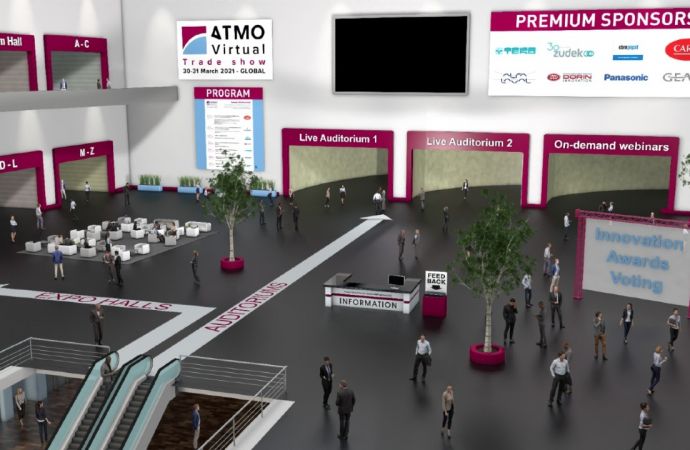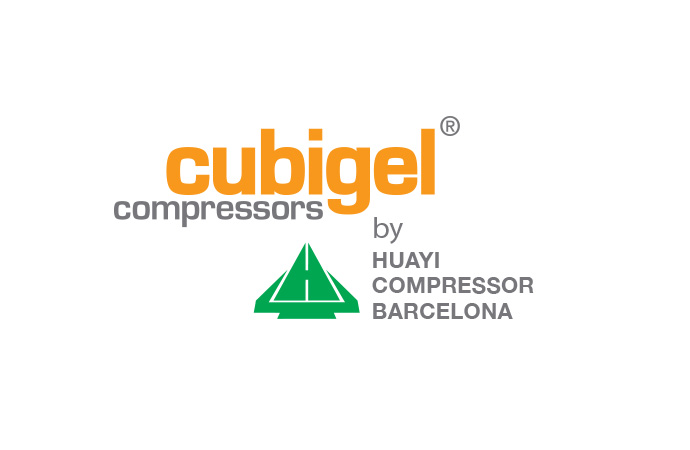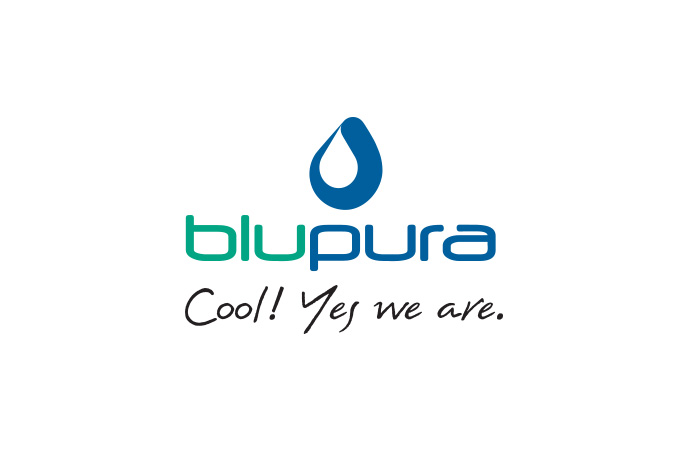Hydrocarbon (HC) technology attracted more attention at ATMO Europe than ever before, with Emerson, Embraco, Huayi and Blupura showcasing their latest solutions. Heat pump and ultralow cascade systems were among the solutions presented, while suppliers continued to discuss EU charge limits. The bottom line: hydrocarbon technology can be found in more and more applications, from water fountains to heat pumps. + VIDEO

Hydrocarbons: A viable natural refrigerant solution for medium temperature commercial refrigeration applications
Emerson’s Venu Kandi endorsed the excellent thermodynamic properties of hydrocarbons and their potential for broader application. Aside from their ubiquity in low temperature cabinets, Kandi said there was potential for hydrocarbons in secondary systems, self-contained cases and condensing units.
“In low temperature display cabinets it’s kind of standard practice to use hermetic compressors with propane and we believe the use of hydrocarbons can be extended to a number of applications,” Kandi said. “Self-contained display cases (using hydrocarbons) – this is a technology that is really emerging.”
Kandi covered two separate installation case studies in his presentation: a project with partner A1 Engineering in the UK and an AHT self-contained case using Emerson’s R290 scroll compressors. At the first location Emerson installed an EU/ATEX certified hermetic R290 scroll compressor. Kandi said it was the ideal solution for flammable refrigerants. Used in a secondary system with R290/water-glycol for mid temperature, the system can produce cooling capacities of 10-63kW at a -6°C supply temperature. With a heat recovery capacity of 12-42 kW at a 50°C supply temperature, the system has 3-6 compressors and a refrigerant charge of 12-16kg. With up to 6 leak detection sensors at critical locations, the solution displays superb safeguarding measures and proves Emerson is at the forefront when it comes to meeting strict regulatory requirements.
The second project was an AHT self-contained case - a fully hermetically sealed refrigeration system with 4.8-7kW cooling capacity. Using a higher refrigerant charge (500-700g), Kandi extolled the unit’s benefits. “It’s factory made, easily installed, and because the leakage of refrigerant is low, the 10-year cost of the system is very low,” he said.
Kandi urged ‘operators to do proper risk assessments on their systems’ and to train installers when it comes to using hydrocarbons. He said each country in Europe had to look into their local legislation regulations in regards to hydrocarbons because (understanding charge limits) is vitally important.
In the UK there are several stores using higher HC charges (700-800g per cabinet). “Local regulations vary between European countries and addressing national restrictions will be one of the keys advancing this market,” Kandi said.
Low global warming alternatives for ultra-low cascade applications
In his presentation, Embraco’s Marek Zgliczynski highlighted the company’s use of hydrocarbons for ultralow temperature cascades applications. Used mainly in the medical and pharmaceutical industry, specifically for lab purposes, the systems must operate in temperatures of -70°C to -90°C. Embraco produces around 200 thousand cabinets per year across a range of markets.
Under a theoretical cycle comparison, Embraco found the efficiency of propane/ethane cabinets to be higher than HFC systems, given the latter typically use the same compressor for both the first and second stage of cascade operation, which is not a very effective method because power consumption is typically much higher in the second phase. Zgliczynski compared a cascade hydrocarbon system with an HFC (R404A/R5088) unit and found the system COP to be higher for HC (0,82) compared to HFC (0,7), with the power usage of the HC compressor (1St stage – 0,72 kW/ 2Nd stage 0,50 kW) lower than the HFC cabinet (0,88 kW/ 0,55 kW).
“If we compare the HFC cascade system efficiency to propane and ethane cascade systems with the same conditions we can see even from a theoretical point of view the benefit of hydrocarbons over HFCs,” Zgliczynski said.
Embraco’s special compressor series for ultralow cascade systems using R170 are also on the market. With a special valve design and optimised torque electric motor, the compressors are the first of their kind optimised for this type of application. Zgliczynski noted that the US has already proposed a protocol for energy consumption for these ultralow applications, presenting a market opportunity for Europe that doesn’t currently exist under ECO design regulations.
U compressor: 14 years of Huayi hydrocarbon compressor evolution
Vincente Guilabert of Huayi Compressor Barcelona spoke about the benefits of the company’s small hermetic compressor and the increasing market towards HC compressors in Europe. The company manufactures plug-in systems where the maximum refrigerant charge is usually not a consideration. Highlighting a typical ice maker case study, the analysis of energy consumption between cabinets shows that with the company’s new U compressor there is an improvement of 26.64% and 6.23% compared to Huayi’s previous best model (NLY60Cab) and the second best product on the market, respectively. The U compressor:
- Is marketed as the most efficient compressor in its field of application
- Has a new shell, is more compact and rounded
- Offers high noise reduction
- Has a COP of 1.8 (+64% from first model in 2001)
An environmentally friendly and highly efficient alternative, Guilabert noted that demand for propane compressors had increased by 39% in 2014 and is predicted to increase by 40% and 42% in 2015 and 2016, respectively.
Huayi has been developing propane solutions for the light commercial market since 2001. Guilabert endorsed the natural refrigerant for its high cooling capacity, but admitted low charge limits remained a hindrance to further uptake in Europe.
“When we started propane was not applicable in all world regions, now it is a global refrigerant solution. It’s an environmentally friendly solution and highly efficient,” he said. “As a small compressor producer, hydrocarbons are considered a high-pressure refrigerant – the other advantage over R134a and other medium or low pressure refrigerants with low displacement, is that we can cover a higher cooling capacity.”
Guilabert said the main challenge remained the base 150g-charge limit in some applications in Europe. Discussions regarding extending the maximum charge are not expected to result in changes in the short term, but perhaps in the medium term. The EU Commission continues to consult member states on what national legislation is creating barriers for the uptake of natural refrigerants.
In Huayi’s lunchtime technomercial, the U compressor range was showcased under the trademark ‘cubigel compressors’, from the smallest capacity D range (2.4-4.03 cc), for small applications like water coolers, right up to the S range (18.0-34.4 cc), for large refrigerators/freezers and blast chillers. Huayi compressor Barcelona manufacturers all of its products in Barcelona, with 90% of their compressors and hermetic condensing units exported around the globe.
Blupura hydrocarbon chillers garnering international attention
The water supplied at the welcome dinner was generated from Blupura’s hydrocarbon charged stainless steel chiller. The innovative Italian company supplies four European market segments with its filtered water chillers: hospitality, water vending machines, outdoor fountains and-high end offices.
Using natural refrigerants R290 and R600a, Blupura’s product range includes the Blue soda – a compact, powerful, and entirely stainless steel chiller. The chiller also uses Blupura’s signature DRY COOLING technology.
Luca Constantini described his company’s approach: “We believe in innovation, our coolers have modern design and we use new materials. We use glass, not plastic and our technology is based on the ice bank, with a touch screen and payment system. Blupura’s patented ice-bank system is equipped with internal filters and video/audio output for presentations and advertising.
There are approximately 200 units installed already in Italy and Constantini said the company continued to receive international enquiries about their technology. Constantini highlighted two public installations – one in Sirolo (Italy) and another in San Francisco (U.S.) – both of which eliminate the need for plastic bottles and generate water closer to the source (creating less pollution).
“The water can be taken with a pre-paid card,” Constantini said. “For example in Italy there are companies that sell pre-paid cards for €5, charged with 100 litres, so the water is sold at five cents per litre, which means it is four or five times cheaper than bottled water in a supermarket. It’s a very good service for the community to supply cool water at an affordable price.
Blupura Technomercial video presentedat ATMOsphere Europe 2015
EU-funded propane water-to-water heat pump booster
José Miguel Corberán presented on behalf of the Universitat Politècnica de València and outlined its EU funded project testing a propane water-to-water heat pump booster for sanitary hot water production.
The university is working with three different units - the compressor is supplied by Danfoss and the hydrocarbon heat exchanger is supplied by Alfa Laval. Corberán considered the excellent properties of CO2 in this application, given the high gas cooler efficiency it supplies at a low temperature input to high water output. However, he noted that when compared to the CO2 cycle, propane represented a good candidate for producing hot water at high temperatures. This is due in part to propane’s low discharge temperature.
“We did some modeling to see if the COPs we could expect were high and the results were good. We were able to analyse what the COP was at different condensation and subcooling pressures. When we took the water temperature of 10°C at the unit of the condenser and we changed the condensation pressure (amount of subcooling) we saw the optimum for each temperature at the inlet (water temperature):“We’re trying to significantly increase the subcooling on the heat pump and trying to maintain good efficiency for the set condenser and subcooling,” Corberán said.
- At 15°C (inlet water temperature to condenser) a COP of 5 of attained
- At 25°C (water inlet temperature to evaporator) COP above 5
“We are asking about the potential market for this,” Corberán said. “We think that it is not huge but there is at least a niche market for low temperature heat recovery – in buildings at industrial level, low temperature hot water processing, commercial moulds, and smaller places like supermarkets where there are condensation loops.”
MORE INFORMATION
Related stories










